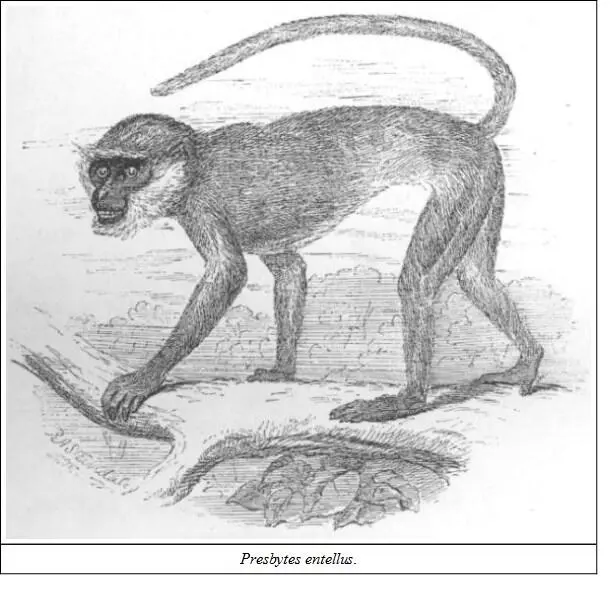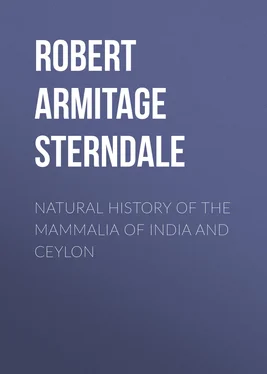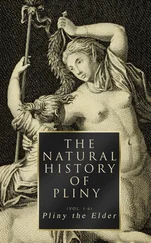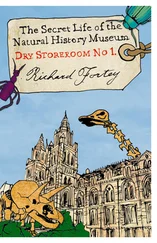Robert Armitage Sterndale - Natural History of the Mammalia of India and Ceylon
Здесь есть возможность читать онлайн «Robert Armitage Sterndale - Natural History of the Mammalia of India and Ceylon» — ознакомительный отрывок электронной книги совершенно бесплатно, а после прочтения отрывка купить полную версию. В некоторых случаях можно слушать аудио, скачать через торрент в формате fb2 и присутствует краткое содержание. Жанр: foreign_edu, Биология, на английском языке. Описание произведения, (предисловие) а так же отзывы посетителей доступны на портале библиотеки ЛибКат.
- Название:Natural History of the Mammalia of India and Ceylon
- Автор:
- Жанр:
- Год:неизвестен
- ISBN:нет данных
- Рейтинг книги:5 / 5. Голосов: 1
-
Избранное:Добавить в избранное
- Отзывы:
-
Ваша оценка:
- 100
- 1
- 2
- 3
- 4
- 5
Natural History of the Mammalia of India and Ceylon: краткое содержание, описание и аннотация
Предлагаем к чтению аннотацию, описание, краткое содержание или предисловие (зависит от того, что написал сам автор книги «Natural History of the Mammalia of India and Ceylon»). Если вы не нашли необходимую информацию о книге — напишите в комментариях, мы постараемся отыскать её.
Natural History of the Mammalia of India and Ceylon — читать онлайн ознакомительный отрывок
Ниже представлен текст книги, разбитый по страницам. Система сохранения места последней прочитанной страницы, позволяет с удобством читать онлайн бесплатно книгу «Natural History of the Mammalia of India and Ceylon», без необходимости каждый раз заново искать на чём Вы остановились. Поставьте закладку, и сможете в любой момент перейти на страницу, на которой закончили чтение.
Интервал:
Закладка:
Jerdon's statement that they can run with great rapidity on all-fours is qualified by McMaster, who easily ran down a large male on horseback on getting him out on a plain.
A correspondent of the Asian , quoting from the Indian Medical Gazette for 1870, states that experiments with one of this genus ( Presbytes entellus ) showed that strychnine has no effect on Langurs —as much as five grains were given within an hour without effect. "From a quarter to half of a grain will kill a dog in from five to ten minutes, and even one twenty-fourth of a grain will have a decided tetanic effect in human beings of delicate temperament."— Cooley's Cycl . Two days after ten grains of strychnine were dissolved in spirits of wine, and mixed with rum and water, cold but sweet, which the animal drank with relish, and remained unhurt.
The same experiment was tried with one of another genus ( Inuus rhesus ), who rejected the poisoned fruit at once, and on having strychnine in solution poured down his throat, died.
The Langur was then tried with cyanide of potassium, which he rejected at once, but on being forced to take a few grains, was dead in a few seconds.
Although we may not sympathize with those who practise such cruel experiments as these above alluded to, the facts elucidated are worth recording, and tend to prove the peculiar herbivorous nature of this genus, which, in common with other strictly herbivorous animals, instinctively knows what to choose and what to avoid, and can partake, without danger, of some of the most virulent vegetable poisons. It is possible that in the forests they eat the fruit of the Strychnos nux-vomica , which is also the favourite food of the pied hornbill ( Hydrocissa coronata ).
NATIVE NAMES.— Langur , Hanuman , Hindi; Wanur and Makur , Mahratti; Musya , Canarese.
HABITAT.—Bengal and Central India.

DESCRIPTION.—Pale dirty or ashy grey; darker on the shoulders and rump; greyish-brown on the tail; paler on the head and lower parts; hands and feet black.
SIZE.—Length of male thirty inches to root of tail; tail forty-three inches.
The Entellus monkey is in some parts of India deemed sacred, and is permitted by the Hindus to plunder their grain-shops with impunity; but I think that with increasing hard times the Hanumans are not allowed such freedom as they used to have, and in most parts of India I have been in they are considered an unmitigated nuisance, and the people have implored the aid of Europeans to get rid of their tormentors. In the forest the Langur lives on grain, fruit, the pods of leguminous trees, and young buds and leaves. Sir Emerson Tennent notices the fondness of an allied species for the flowers of the red hibiscus ( H. rosa sinensis ). The female has usually only one young one, though sometimes twins. The very young babies have not black but light-coloured faces, which darken afterwards. I have always found them most difficult to rear, requiring almost as much attention as a human baby. Their diet and hours of feeding must be as systematically arranged; and if cow's milk be given it must be freely diluted with water—two-thirds to one-third milk when very young, and afterwards decreased to one-half. They are extremely susceptible to cold. In confinement they are quiet and gentle whilst young, but the old males are generally sullen and treacherous. Jerdon says, on the authority of the Bengal Sporting Magazine (August 1836), that the males live apart from the females, who have only one or two old males with each colony, and that they have fights at certain seasons, when the vanquished males receive charge of all the young ones of their own sex, with whom they retire to some neighbouring jungle. Blyth notices that in one locality he found only males of all ages, and in another chiefly females. I have found these monkeys mostly on the banks of streams in the forests of the Central Provinces; in fact, the presence of them anywhere in arid jungles is a sign that water is somewhere in the vicinity. They are timid creatures, and I have never seen the slightest disposition about them to show fight, whereas I was once most deliberately charged by the old males of a party of Rhesus monkeys. I was at the time on field service during the Mutiny, and, seeing several nursing mothers in the party, tried to run them down in the open and secure a baby; but they were too quick for me, and, on being attacked by the old males, I had to pistol the leader.
5 5 Mr. J. Cockburn, of the Imperial Museum, has, since I wrote about the preceding species, given me some interesting information regarding the geographical distribution of Presbytes entellus and Hylobates hooluck . He says: "The latter has never been known to occur on the north bank of the Brahmaputra, though swarming in the forests at the very water's edge on the south bank. The entellus monkey is also not found on the north bank of the Ganges, and attempts at its introduction have repeatedly failed." P. schistaceus replaces it in the Sub-Himalayan forests.
NATIVE NAMES.— Langur , Hindi; Kamba Suhú , Lepcha; Kubup , Bhotia.
HABITAT.—The whole range of the Himalayas from Nepal to beyond Simla.
DESCRIPTION (after Hodgson).—Dark slaty above; head and lower parts pale yellowish; hands concolorous with body, or only a little darker; tail slightly tufted; hair on the crown of the head short and radiated; on the cheeks long, directed backwards, and covering the ears. Hutton's description is, dark greyish, with pale hands and feet, white head, dark face, white throat and breast, and white tip to the tail.
SIZE.—About thirty inches; tail, thirty-six inches.
Captain Hutton, writing from Mussoorie, says: "On the Simla side I observed them also, leaping and playing about, while the fir-trees, among which they sported, were loaded with snow-wreaths, at an elevation of 11,000 feet."—'Jour. As. Soc. Beng.' xiii. p. 471.
Dr. Anderson remarks on the skull of this species, that it can be easily distinguished from entellus by its larger size, the supraorbital ridge being less forwardly projected, and not forming so thick and wide a pent roof, but the most marked difference lies in the much longer facial portion of schistaceus ; the teeth are also larger; the symphysis or junction of the lower jaw is considerably longer and broader, and the lower jaw itself is generally more massive and deep.
NATIVE NAME.— Gandangi , Telugu.
HABITAT.—The Coromandel Coast and Ceylon.
DESCRIPTION.—Ashy grey, with a pale reddish or chocolat-au-lait tint overlying the whole back and head; sides of the head, chin, throat, and beneath pale yellowish; hands and feet whitish; face, palms and fingers, and soles of feet and toes black; hair long and straight, not wavy; tail of the colour of the darker portion of the back, ending in a whitish tuft.— Jerdon .
SIZE.—About the same as P. entellus .
Blyth, who is followed by Jerdon, describes this monkey as having a compressed high vertical crest, but Dr. Anderson found that the specimens in the Indian Museum owed these crests to bad stuffing. Kellaart, however, mentions it, and calls the animal "the Crested Monkey." In Sir Emerson Tennent's figure of P. priamus a slight crest is noticeable; but Kellaart is very positive on this point, saying: " P. priamus is easily distinguished from all other known species of monkeys in Ceylon by its high compressed vertical crest."
Читать дальшеИнтервал:
Закладка:
Похожие книги на «Natural History of the Mammalia of India and Ceylon»
Представляем Вашему вниманию похожие книги на «Natural History of the Mammalia of India and Ceylon» списком для выбора. Мы отобрали схожую по названию и смыслу литературу в надежде предоставить читателям больше вариантов отыскать новые, интересные, ещё непрочитанные произведения.
Обсуждение, отзывы о книге «Natural History of the Mammalia of India and Ceylon» и просто собственные мнения читателей. Оставьте ваши комментарии, напишите, что Вы думаете о произведении, его смысле или главных героях. Укажите что конкретно понравилось, а что нет, и почему Вы так считаете.












